In Part 1 I discussed how the hind leg works via the ‘stay system’, as well began to discuss angulation within the leg. In Part 2 I’m going to talk about ‘gearing’, and hock and stifle placement.
Gearing – A horse has but one gear, so it’s important to pick the right horse for the task. How a horse is geared is determined by the proportions of the bones in the hind limb, their ratio to each other individual and as a whole. Those bones are the iliac part of the pelvis, femur, tibia (gaskin), cannon bone, pastern and hoof. Adding those bone lengths together will give you Total Hind Limb length (THL). THL is then compared to the horse’s height at the croup. Adjustments in the croup height have to be made if the horse is croup high or croup low (such as standing parked out). Even though it’s important to understand THL, I’m going to avoid going too in depth. To do so would put dozens and dozens of numbers in front of your face, and after a while you’d want to shove those numbers right up my you-know-what. I’ll pick a few strategic places to talk about it to give you an idea.
The hind leg acts much like a chain pendulum. If the upper link of such is short, it will swing rapidly back and forth in a relatively short arc – think cuckoo clock. Any links attached below, even long ones, will also swing rapidly in a relatively short arc. If the upper link is long, then the pendulum will swing slowly in a long arc – think Grandfather clock. Any links attached below, even short ones, will also swing in a long, slow arc.
The bone with the biggest determining factor in this chain pendulum type of gearing in the hind leg is the femur. Therefore a short femur will give short, quick strides as you’d want in a racehorse or a draft (first gear), and a long femur will give longer, slower strides as you’d want in all other equine disciplines (third gear).
A short versus long femur is determined by looking at THL, but also by comparing it directly to the tibia. A horse geared in first will have a femur that is clearly shorter than the tibia, while a horse geared in third will have a femur that is at least as long as the tibia or longer.
A disadvantage of a long tibia is that it tends to create the conformation faults bow-legged or cow hocked. It will also cause destabilization in the hind leg and when moving these horses tend to twist their hocks. Strengthening the abductors and adductors through lateral work can help reduce the twisting.
Hock And Stifle Set – The simplest way to say this: the higher the hock and stifle (that is away from the ground) the more the horse must work and engage to shift weight rearward and lower the haunch.
The hock can never be lower than the knee, but the closer to knee height the better for your riding horse. High hocks via a long cannon bone tend to cause the hocks to pogo up and down rather than to come forward and under the horse. If you were to combine that with a short femur, that signifies the short, quick stroke of first gear, you can readily imagine how much harder it just got for the horse to bring those hocks forward and underneath the body.
The stifle can be lower than the elbow, though rare; we do want to see the stifle at least close to elbow height for riding horses.
Our skeleton horse has a low hock set with the hock ever so slightly higher than the knee, and a low stifle set with the stifle lower than the elbow. It is, however, a post-legged skeleton. Post-legged means that the angles created at the joints (particularly the stifle and hock) are too open. Post-legged also means the leg is too short. Longer bones would create a more ‘Z’ shape, therefore more angulation.
Let’s look at our sample horses more closely.
Horse #1 – 10yr old QH Stallion
This horse has a desired low hock. The stifle is set high. While the tibia is long when considering THL (it’s the highest ratio bone), it’s just as much that he’s generally short-legged in front that puts that stifle where it is.
He has a tibia that is clearly longer than the femur, which is what we’d expect from his sprinter-type build. The femur is short (indeed the same length as the cannon bone) representing only about 21% of THL, so this is a first gear horse. In fact, he’s a little short overall in the THL department and thus is a bit post-legged. Still, here’s an individual who is going to be powerful and quick.
Horse #2 – QH Gelding
This horse also has a low set hock, but with a lower stifle than the first.
This horse’s tibia is also clearly longer than his femur, while the femur represents a slightly higher ratio (22.5%) of THL than in our first horse; this guy is still geared for first.
Compare the hock angles of the two horses. They are identical at 151 degrees. The stifle angles differ by a few degrees – 125 for the roan, 122 for the stallion. The thigh angles differ the most with the roan at 98 degrees and the stallion at 103 degrees. Summarized: the stallion is more open in his top most joint, the roan more open in the stifle, both are the same in the hock. Now note the difference in stance of the two horses.
The roan horse is standing too far underneath himself, artificially closing the joints of his hind leg; see that his cannon bone is not perpendicular to the ground and that the cannon bone falls quite a distance in front of the plumb line, the latter often an indicator of post-leggedness.
At this point you have to use a little imagination and move the roan’s hind leg back a bit so as to create a perpendicular cannon bone. That will open all the joints in his hind limb including that hock angle, per the rules of the hind leg stay system. (Refer to Hind Limb – Part 1 concerning stay system as well as maximum angle created at the hock during full extension.) By doing so, that will make the hock too open, and the horse too straight, and therefore post-legged. This at first might seem a contradiction when we also discover that this horse has a 3% higher percentage THL to croup height than our stallion. In other words, compared to his croup height, this horse’s hind leg is 3% longer than the stallion. And yet…this horse is more post legged than the stallion.
One other thing that happens when we move that cannon bone perpendicular and open all the joints of the leg, the horse’s croup rises and the horse becomes croup high. That then affects his overall body levelness and increases the difficulty of engagement.
Undoubtedly part of this horse’s stance problem behind is the horrid trim job on his feet. Not only are the angles way too low, the toes proportionately too long to the too short heels, but he’s also got to be walking on his soles. Imagine having those hind feet balanced properly. What will that do to the angles in his leg and the height of his croup?
The same foot problem exists on the front and we see the horse standing over his shoulder with his front legs too far underneath himself. This horse stands over several less inches of ground than he should due to unbalanced feet, conformation and pain.
In terms of athleticism, this horse too will be powerful and quick but not as much as our stallion, and there’s going to an additional problem. Right before landing and right after pushing off, he won’t be able to fully extend the upper portion of his leg because of the post-leggedness in the lower portion of the leg. He’ll be prone to hyper extending through the hock if pushed to engage. Indeed, his hocks show wear and tear. Thusly, as a means to protect himself he will take shorter strides.
Here is a horse with a similar hind leg construction and as post-legged as the day is long. Look at how open the hock angle is on landed leg; 150 degrees and yet the horse hasn’t taken any kind of a deep step.
In this second picture the hocks of both the leg leaving the ground and the leg landing are as open as is physically possible (160 degrees). This is as big a step as this horse can take, regardless of more joint range higher up. You can’t tell from the photo, but the horse is travelling on a bit of an upgrade and that’s what’s helped him take the step behind.
Moral of the story, avoid obvious post-legged horses regardless of pretty much every other strength the horse may possess because it’s next to impossible to engage them, and that is what’s needed to protect the horse’s long term health and soundness.
Horse #3 – 4yr old QH
This horse possesses the lowest placement of hocks to knees as a horse can get. Because he has low knees, thanks to those short cannon bones, he also has low set hocks. His stifle is set a bit higher than the roan gelding, but lower than the stallion.
This QH has a proportionately longer femur than the previous two (25% of THL), as well the femur is at least as long as the tibia. The horse also has more THL than the previous two horses, making him the longest legged of the three. (Indeed, he’s got the longest femur proportionately and the highest THL of all our sample horses.) There’s still plenty of power here, but this horse’s hind leg stroke is going to naturally be longer and slower than the first two. Western Pleasure anyone?
Even though the horse is standing with the cannon bone not quite perpendicular to the ground (and a little in front of the plumb line, notice that the angles at the joints are more similar to each other (concordant), creating a more even ‘Z’ shape.
I’m disappointed in this horse’s front end muscling. While he’s downhill, longer through the body, and doesn’t possess the highest set neck (all things that increase the difficulty of engagement), there’s really no excuse for the excessive lumpiness and over development. Someone has been peanut rolling this horse, allowing him to pull himself with his front end and trail his hocks.
Horse #4 – Arabian Stallion
While the hocks are placed just ever so slightly above the knees on this horse, this is not a low hock set, but rather a high one. This is because the horse has high knees. Still, it’s a better high hock set to have than one via hocks significantly higher than knees.
The elbow is also high on this horse (leggy horse – stands over a lot of air), the stifle just ever so slightly higher than the elbow, but still it’s considered a low stifle set.
I’ve got nothing good to say. The tibia is clearly quite a bit longer than the femur, and the femur itself is short with approximately the same ratio to THL as the roan QH. Add to that stifle and hock angles that are wide open, a merely adequate pelvic length and a table top croup. Imagine a pogo stick that’s been broken in half and then duct taped together; that’s how I’d expect this horse to move behind. At least his head is pretty.
Horse #5 – TB Gelding
I drew the line from knee to opposite hind leg since this horse is standing with the near leg forward. This is a high hock set both because of its relationship to the knee and its relationship to the ground; another horse with a high knee. The stifle is also set a bit high, typical of the breed and what you’d expect from a distance runner.
The tibia is longer than the femur and both hock and stifle angles are open. This is a typical hind leg of many TB racehorses, except a bigger hip would be wanted. This horse is not nearly as powerful or quick as the bigger-hipped, sprinter-type QH stallion, but still falls in the first gear category. This is another one where the high hock and long tibia can result in hock twisting.
Here I attempted to mark the off leg to give you a better idea of what it looks like when the horse is standing properly.
Horse #6 – Paint mare
The hock set on this horse is okay, but unfortunately she possesses the highest stifle set of the group, due in significant part to the super long scapula and short forearm which puts her elbow low, but also because of her long tibia and short femur which raises the stifle.
This mare also falls into the first gear category with a short femur and long tibia. She’ll have quick, short strides behind, but will lack the speed and power of the QH stallion. She’s not standing with the cannon bone perpendicular to the ground, so her angles are going to open a touch more.
Below I’ve added a horse that is very specifically built for riding in almost every way. As it relates specifically to this article, though; third gearing, long femur, short tibia, low hock and stifle set, along with a big hip and superior loin coupling.
By request here is a riding conformed individual with an over-angulated hind leg. This is a leg that is too long for the body. In this case THL represents 120.5%. You can see the closed angles of the stifle and hock. Over-angulated is less severe of a fault (provided it’s not excessive – this is as much as I’d ever want to see on a horse) than post-leggedness. Invariably the ability to engage is more difficult and these horses find it easier to trail their hocks than try and fit all that leg underneath themselves. These horses can forge, step on their front heels bulbs, or pull shoes more easily. Sometimes they’ll develop a hop to their gait as they try to hold the hind foot from landing a fraction longer so that the landed front foot can get out of the way. They can also step wide behind (place hind foot outside of the front foot). Hock twisting is prevalent and they can develop conditions such as curbs, as well the usual stress to the sacrum, loin and back from wanting to travel hollow.
And so ends this conformation series. (Finally!) Now is the time to place our sample horses into order of worst to best *riding* conformation. This is a lot more difficult than it might first seem. To pick the best you will have to consider many aspects and grade them according to what can be outright ignored, what can easily be overcome, what’s going to be hard to overcome, and what’s impossible to overcome. I will post my ratings with explanation in the next week or so.













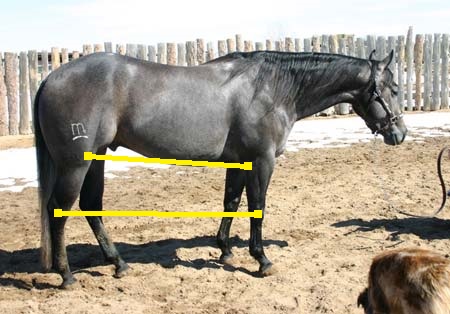
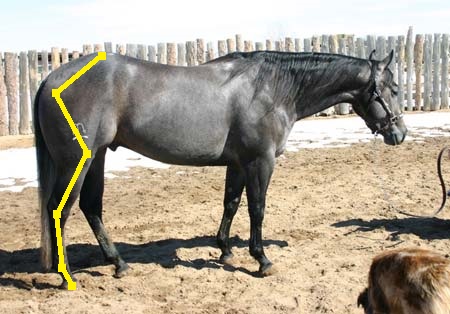

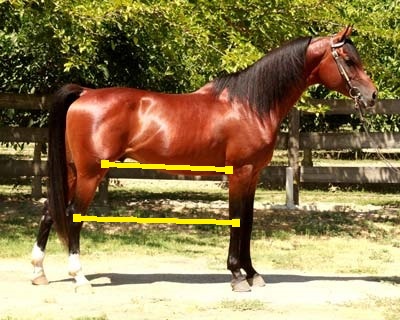

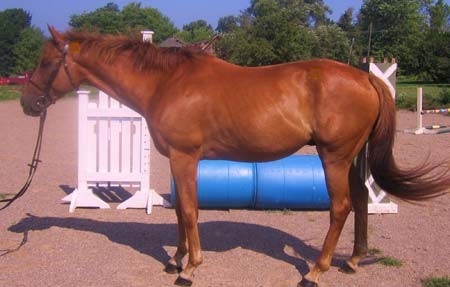
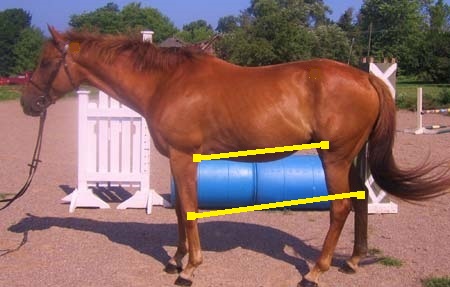
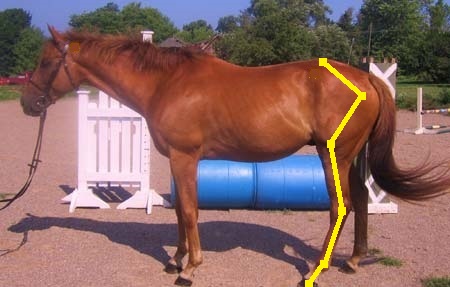






I can see I am going to have to spend some time on this. Thanks!
Yes, I had the same reaction when I began learning this part of conformation. Be very, very thankful I didn’t do a full chart of numbers for this group of horses. LOL!
I am going to go ahead and give this a whirl:
1) QH stallion
2) chestnut TB
3) blue roan QH
4) red roan QH
5) Arabian stallion
6) Paint mare
I may be way off base, but I’ve been thinking about it for a while and if I’m wrong, I’ll get to learn why! 🙂
And by the way, “1” is best and “6” is worst.
Merc – can you add an overly angulated hind limb to this post? As most of my gang resemble similar to the QH stud or Blue Roan gelding, I know this leg well. I do have another member of the barn with quite the opposite leg, can there be a 6th gear? 🙂 He is quite sickle hocked, hind cannons when perpendicular to the ground will intersect easily 6″+ behind point of rump. He has a long, slow stroke with a deep overstep. What are the risks associated with overly closed joints over time? He seems to have a good range of motion, articulating joint each when striding.
if he were truly sickle hocked, a bony abnormality, he probably couldn’t get the cannon perpendicular.
http://www.missourifoxtrottersatoz.com/distinguishing%20conformational%20flaws%20from%20poor%20posture.htm
I think the distinction between a sickle hind leg and horse standing under itself are greatly misunderstood. My rule of thumb has been that if a straight line drawn from the cannon up, regardless of leg position, doesn’t intersect point of butt, then the horse is sickle hocked with an overly angulated hind leg.
The correct technical definition of sickle hocks is when the hocks can not fully open. As in, it’s impossible for the joint to open. Sickle hocks are also often misshapen and/or small.
ditto to Mercedes. One would never buy a truly sickle hocked horse for riding, it is a lameness issue that is manifest. I know the qh breeders mistakenly like over angulated hocks thinking it helps the horse get up under itself. They are still wrong, that doesn’t make a sickle hock, and it doesn’t make a horse that gets up under itself correctly.
We haven’t talked directly too much about the proper weight bearing on the leg, we talked about proper angulation and the SI joint a lot, but less about weight in movement. The rear leg is a z spring, but compression (closure) of the hock joint is controlled at the level of the SI and femur, to the degree the first joint closes, the tibia/hock/cannon closes. Having an over angulated lower joint doesn’t allow the hock to close tighter, it has restricted the natural movement of the hock. Properly angulated joints moving within the limits of the design of the muscles/ligament movement/stabilization of the joints of the rear limb bear weight best and allow correct and balanced weight bearing.
Sure…give me a couple hours and I’ll add an over-angulated individual.
Nice to have you back. Not one of these is a riding horse except the grey you added. I made my choice a long while back and haven’t changed my mind. But I’ll wait to say my say until later.
I apologize to all for not being around much the last couple of months. Being ‘legal’ has allowed me to pick up some work with horses, so I’ve been busy training.
I believe we’re in agreement on the other and I look forward to your comments on the summary article.
If I had to own any of those I’d only want the grey then 1 and 4 and in that order.
Every time you use these horses I keep looking at 1 and thinking “that can’t really be a quarterhorse” 😉
I’ve almost become so used to seeing crap ones that I’m shocked when there’s a nice one…I’ve kind of got where I’m expecting “quarterhorse” to mean “YUCK, this will make your eyes bleed” though in fact one of the nicest horses I’ve ever personally come across and ridden was a quarter horse over in the USA.
I’ve been thinking for some time that quarterhorses have become the product of their disposition and ease and popularity. A bit like Labradors: There’s a lot more poor quality around to go reproducing.
I do like the one you’re using in this blog though. What’s his name? breeding etc? You might have said somewhere and I’m forgotten or missed it?
I don’t have specifics about the sample horses but for the two stallions. I’ll disclose what I know about them in the summary.
You tease!
When will the summary be???
Like I said in the article, a week or two less the number of days since I posted the article. 🙂
That must have been past the point where I got bored and stopped reading and had decided which horses I preferred 😉
I’m going to throw my picks out with a touch of personal preference and not all conformational strengths I’m afraid.
#1 – Blue QH gelding. I don’t find any significant flaws and find him attractive and fairly well balanced. He has a lovely neck though low set, strong hip, adequate bone & pastern length, appears healthy and strong enough to save him from the WP world. I would love to western dressage him.
#2 – QH Stallion. I place him second as he seems like an excellent individual for speed events, roping, but I’m not fond on his front pasterns or overly short back.
#3 – TB gelding. Though he has a long back and too high knees and hocks, he looks to me to be a nice individual for flat work and hacking out. With his good hip/SI placement, he might be able to become a low level hunter.
#4 – Roan QH. I can’t get past his hind limb straightness though he has good bone and great body depth. I’d worry about soundness issues behind.
# 5 – Arab stallion. I don’t think Arabs make good riding horses and this guy’s hind end screams ‘trailing legs’. His body is too shallow, legs too long. When I say riding horse, I exclude endurance and consider low level dressage. I don’t think he could put himself together.
# 6 – Paint mare. She screams terribly heavy on the forehand. Her neck indicates how she will travel (inverted), pasterns too short, point of shoulder too low. The only thing I like about this mare is the angle of her hind limb, not upright but not sickled either.
The grey you posted as an example of a nice hind end – do my eyes deceive me, or is this horse a bit calf-kneed and tied in up front? Between the grey color, the dappling, and the shadows I can’t tell 🙂
Thank you!
The QH stallion is calf-kneed ad tied-in. The grey is as straight through the knee as you’d want to see. Perhaps a tick tied-in. Hard to say if he’s standing awkwardly on the left or if it’s crooked.
I chose the tb early on and didn’t change my mind. He exhibits the closest overall balance to a riding horse. He has a strong SI connection, well placed, well muscled with the muscling thick and full over the loin. While he has typical tb issues, gearing, as you call it for first gear, a little light of bone, he has better looking than average tb feet, and tb’s have proven resilient athletes despite these issues. We disagreed early that his hip was accurately portrayed, while not a large hip more typical of tb’s, it is adequate for a riding horse. I believe the angle of his leg foreshortens the look of the femur and while just adequate, he is nevertheless adequate. His SI placement will mean he gets the most out of what hip he has. I also suspect from the slightly weedy look while being deep through the heart and flank girths, that he is young, meaning shoulder, withers and length of femur may in fact change, giving him slightly more hip (but not different angulation). He is less post legged than the first two quarter horses, I’ve owned some rather posty quarter horses, it affects there gaits and it can predispose them to more stiffness through the hocks as they age, if coupled with shorter femur, longer tibia it also leads to stifle problems. His shoulder is a little upright, but meeting the minimum requirements of openess to have good reach.
I believe he is also less downill than the quarter horses, though not level as the arab stallion is. His neck is more ‘straight out the front’, the way it ties in at the shoulder places it about halfway of the shoulder, at the point where Dr. Deb says any horse can achieve a level spine by muscular effort, and he has the SI joint to allow him to do that. He has a more level spine for saddle fitting than the first two qh’s, that would be a blessing in purchasing a saddle for him.
I would avoid the roan qh, too straight in the backend,stifle set too high, more downhill and the kind of look that says too much halter horse blood to me.
The quarter horse stallion is what a quarterhorse was meant to be, which was never a riding horse, but a running, cattle, working horse with quickness, power, sprinter’s speed, sufficent bone to last, he’s a great horse, but he isn’t a riding horse.
The third quarterhorse, also young has a good hip, nicer leg angulation, but too low set a neck. Bred by people who think a low neck means a low head. They have made it so that horse will have a hard time achieving a level spine.
The arab would make a great park horse for modern times. Flashy front legs, trailing hocks, lugging around on the forehand, but pretty. You can create a flat croup over the top line without ruining the hip, but most modern breeders don’t know any better, the outside outline not the bones is what they see.
The little paint mare is in last place, she is just shy of good on most points of her top line, not quite as low in knee or hock as you would like. But she will always be a project.
I think that we saw no riding horses in the original group says something about the US horse market. People don’t know what to look for.
I just wanted to say THANK YOU. It’s been a great series and I’ve learnt a lot.
You are most welcome!
Hijacking the thread – sorry. I saw this, you probably already have…dressage using only a cord. I was mesmerized. https://www.youtube.com/watch?feature=player_embedded&v=T9D1vEP98rc
Thank you for sharing that video! I hadn’t seen it. Makes you want to run out to the barn and try it with your own horse, eh?
Uhmmm…yeah – if you have THAT horse. 🙂
Was that rider wearing any pants atall?
I was afraid of what I was going to see as the horse came towards camera….
very nice article. I’ve followed the whole series, now I’ve got to photograph my two horses and check out the results. the over angulated horse could describe my appendix QH perfectly, so I want to measure him now and see if he is conformed this way. he has a huge striding walk, a really comfortable trot and a beautiful l rocking horse canter. his preferred method of transitioning to the trot is to hop with his front end, and motor around on his forehand.
I want to find the beginning of the series!!!